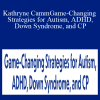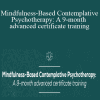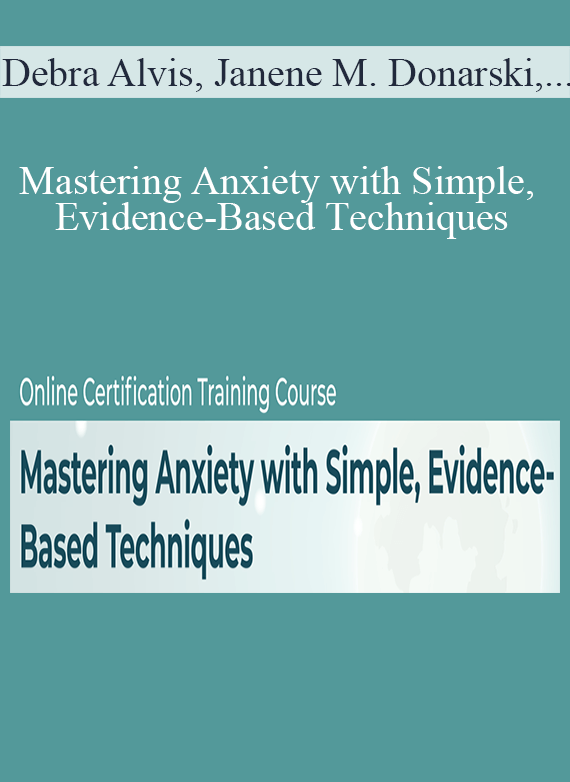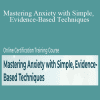Debra Alvis, Janene M. Donarski, Margaret Wehrenberg, and more! – Mastering Anxiety with Simple, Evidence-Based Techniques: A Certified Clinical Anxiety Treatment Professional & Certified Mindfulness Informed Clinician–Level 1 Online Training Course
$249.00 Original price was: $249.00.$72.00Current price is: $72.00.
Digital Download: You will receive a download link via your order email
Should you have any questions, please contact us: [email protected]
 Debra Alvis, Janene M. Donarski, Margaret Wehrenberg, and more! – Mastering Anxiety with Simple, Evidence-Based Techniques: A Certified Clinical Anxiety Treatment Professional & Certified Mindfulness Informed Clinician–Level 1 Online Training Course
Debra Alvis, Janene M. Donarski, Margaret Wehrenberg, and more! – Mastering Anxiety with Simple, Evidence-Based Techniques: A Certified Clinical Anxiety Treatment Professional & Certified Mindfulness Informed Clinician–Level 1 Online Training Course
modalities like CBT, DBT, ACT and somatic therapies so successful…And earn DOUBLE certification in anxiety treatment and
mindfulness-informed therapy—all in one self-paced online course
You’ve heard about the power of mindful awareness for treating anxiety. Now, discover how to apply it in therapy in an individualized way that helps clients immediately see the positive impact on their symptoms, and their lives.
Treating anxiety with mindfulness tools is NOT about trying to change problematic behavior. It’s about strengthening the neural pathways that promote positive emotions, focused attention, and self-compassion. The desired behavior follows.
When you give your clients mindfulness exercises to practice between sessions, you give them the tools to:
- Activate the insula region of the brain so they can control shallow breathing, tightening muscles, and other physical symptoms of anxiety…
- Shrink their amygdala to lessen fear and anxious arousal, and
- Increase frontal cortex activity (emotional self-regulation) so they can more easily manage worrying thoughts and feelings.
The best part? When you change the brain, new habits and positive behaviors stick way better than trying to muscle through cognitive behavioral changes on willpower alone…
Making mindfulness techniques the perfect complement to your practice.
WHAT YOU’LL FIND IN THIS COURSE
Part I | Certified Clinical Anxiety Professional (CCATP) Certification Training
This part of the course provides all the training you need to become a CCATP and enhance your practice.
Dr. Janene M. Donarski integrates brain-based strategies for calming the anxious mind that motivate lasting change in your clients. Her approach also promotes adherence to treatment and strengthens the therapeutic alliance.
Using Neuroscience in the Treatment of Anxiety
- What we know about anxiety-based disorders
- Scientific explanations, evidence, authority that destigmatize difficulties
- Helping clients take responsibility for their well-being
Enhancing Engagement in Treatment
- Don’t neglect the therapeutic relationship!
- Address the challenges of anxious clients
- Guide the process using client’s goals
- How to maintain motivation
Neuroplasticity
- Define Neuroplasticity in everyday language
- Therapy is about creating a new self
- “Rewiring” as an accessible concept for change
- Re-consolidation: the modification of emotional memories
Identify Two Neural Pathways to Anxiety
- Amygdala – bottom-up triggering of emotion, physicality of anxiety
- Cortex – top-down emotion generation based in cognition
- How anxiety is initiated in each pathway and how pathways influence each other
Client Friendly Explanations
- Fight/flight/freeze responses
- The “language of the amygdala”
- Anxiety and the cortex
- Help clients recognize the two pathways to anxiety
Neuroplasticity in the Amygdala
- Breathing techniques to reduce activation
- Exposure as opportunities for the amygdala to learn
- Combatting avoidance
- Push through anxiety to change the amygdala
Neuroplasticity in the Cortex
- The healthy (adaptive) use of worry in the cortex
- Recognize and modify the impact of uncertainty
- Left hemisphere techniques – cognitive defusion, coping thoughts, fighting anticipation
- Right hemisphere techniques – imagery, music
Neuroplasticity and Medications for Anxiety Disorders, OCD, PTSD, Depression
- The myth of the chemical imbalance
- The danger of sedating the brain with benzodiazepines
- Promoting neuroplasticity with SSRIs, SNRIs
- The effectiveness of CBT and meds
Moving Beyond Diagnostic Categories to Focus on Anxiety Pathways
- Anxiety is a component of many diagnoses
- Amygdala – and cortex-based techniques help in other disorders
- Targeting brain-based symptoms rather than disorders
- Worry, obsessions, rumination respond to similar cortex-based techniques
- Panic, phobic responses, and compulsions respond to amygdala-based techniques
Research, Risks and Limitations
- Empirical versus clinical and anecdotal evidence
- Clinical considerations for specific clients and settings
- Efficacy of particular interventions may vary
Methods that control physiology, reduce tension, and offset panic or acute anxiety can be simple to learn but challenging to apply. Bestselling author and anxiety expert Dr. Margaret Wehrenberg gives you a complete set of tools proven to reduce anxiety:
Assessment and Differential Diagnosis
- The causes of panic, generalized anxiety and social anxiety that help select treatment
- Differential diagnosis in children – ADD and ASD
- Treatment approaches that change brain function for long-lasting recovery
- The impact of insomnia in generalized anxiety
Techniques That Work to Modulate Physiology
- The right way to teach and use diaphragmatic breathing
- Develop the 4 competencies of stress management
- Utilize different types of relaxation and discuss their use in different types of anxiety disorders
- Four important lifestyle changes everyone can make to reduce anxiety
Techniques for Treating Cognitive Problems of Anxiety and Panic
- The best thought-replacement methods for worry and rumination
- Clear the mind of ruminative and racing thoughts
- Know when anger triggers anxiety and how to work with it in worried clients
- How to stop worry before it happens
Techniques for Managing Social Anxiety
- Apply the “Three Deep Breaths and Good Preparation” model to construct treatment goals for social anxiety
- Structure cognitive change through planned “counter-cognitions”
- Apply ‘in vivo exposure’ techniques that optimize recovery from social anxiety
Limitations of the Research and Potential Risks
- Controlled studies on the human brain structure and function are limited by challenges of studying the brain in action
- New studies continually modify our understanding of how neurotransmitters interact and affect cognition, emotion and behavior
- There are no significant risks associated with Cognitive-Behavioral Therapy
- Assessment of an individual’s capacity to understand and utilize an intervention should always precede employment of the technique
Part II | Certified Mindfulness-Informed Professional (CMIP) Training
Immerse yourself in Deb Alvis’s flagship, in-depth training into mindfulness tools that have been proven to change neural pathways so clients can reduce their symptoms of anxiety for good. This part provides all the training you need to become a CMIP and enhance your practice.
Mindfulness and the Clinician
- Empirical support for improved symptomology and well-being
- The latest research on therapists who practice mindfulness
- Your mindfulness practice and how you can embody mindfulness
- Situations that may contraindicate applying mindfulness in session
Mindfulness Psychoeducation Approaches to Enhance Motivation in Therapy
- Mindfulness vocabulary
- Visuals and metaphors to explain mindfulness
- Motivate clients with neuroplasticity
Deepen the Therapeutic Relationship by Building Presence, Trust and Empathetic Connection with Clients
- Overcoming barriers
- Affect regulation techniques for therapist and client
- Strategies to create empathetic connection
- Exercises to build clients trust in themselves
Teaching Mindfulness to Clients
- Tips for teaching clients about the senses and awareness
- Strategies to shift from “Automatic Pilot”
- Skill building interventions to increase responsiveness & reduce reactivity
- How to adapt practices to special populations
Anxiety and Stress
- Breathing practices that break the rumination cycle
- Movement strategies
- Multi-sensory regulation techniques
- Mindfully reduce the intensity of panic attacks
Mindfulness for Trauma
- Exercises to counter fight or flight
- Guided meditations to disempower intrusive thoughts
- Grounding exercises and sample scripts
Using Mindfulness in Depression Treatment
- Recognize self-criticism and respond with self-love
- Manage negative self-talk with awareness of thoughts
- Meditations to boost well-being
Mindfulness for Addictions
- Awareness vs. autopilot — relapse prevention
- Mindfulness for triggers
- Emotional regulation for cravings
- Practices to break the habit loop
Mindful Anger
- Breathe through anger
- Distraction and grounding techniques
- Self-soothing techniques
Mindfulness, Diversity, & Cultural Humility
- Adapt mindfulness experiences with cultural sensitivity
- Assess appropriateness of mindfulness interventions for individuals
- Negotiate the treatment plan
Mindfully Conquer Compassion Fatigue
- Right here/right now – stay in the moment to reduce anxieties
- Effective and healthy ways to manage your emotions
- Change limiting stories about caring for yourself
- Release the negative – 3 steps to countering negativity bias
MEET YOUR EXPERTS
Click here for information about Debra Alvis
Click here for information about Janene Donarski
Click here for information about Margaret Wehrenberg
Click here for information about Elana Rosenbaum
Click here for information about Donald Altman
Sale Page: https://catalog.pesi.com/sales/bh_c_001422evg_masteranxietymindfulness_organic-152139
Archive: https://archive.fo/XgRWh





Reviews
There are no reviews yet.